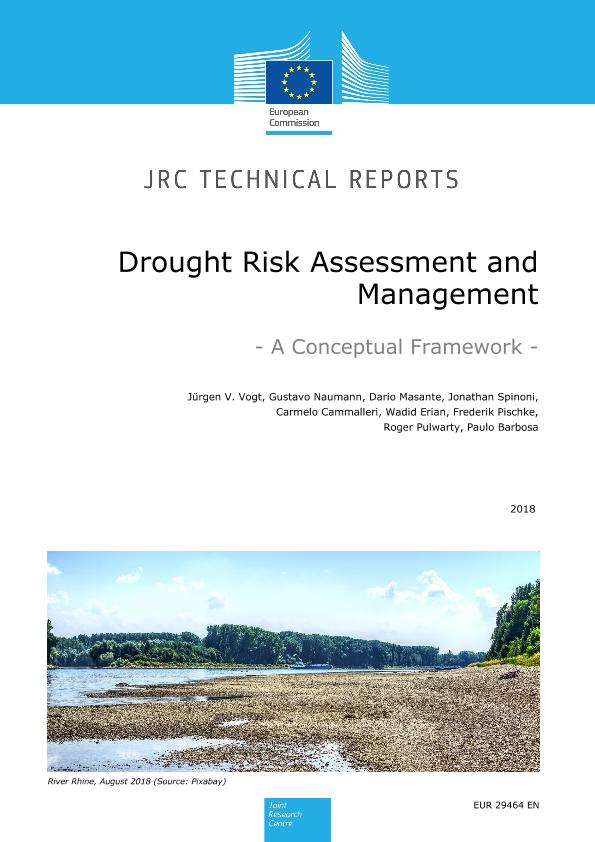Libro
Drought risk assessment and management: A conceptual framework
Vogt, Jürgen V.; Naumann, Gustavo ; Masante, Darío; Spinoni, Jonathan; Cammalleri, Carmelo; Erian, Wadid; Pischke, Frederik; Pulwarty, Roger; Barbosa, Paulo
; Masante, Darío; Spinoni, Jonathan; Cammalleri, Carmelo; Erian, Wadid; Pischke, Frederik; Pulwarty, Roger; Barbosa, Paulo
 ; Masante, Darío; Spinoni, Jonathan; Cammalleri, Carmelo; Erian, Wadid; Pischke, Frederik; Pulwarty, Roger; Barbosa, Paulo
; Masante, Darío; Spinoni, Jonathan; Cammalleri, Carmelo; Erian, Wadid; Pischke, Frederik; Pulwarty, Roger; Barbosa, Paulo
Fecha de publicación:
2018
Editorial:
European Union
ISSN:
1831-9424
ISBN:
978-92-79-97469-4
Idioma:
Inglés
Clasificación temática:
Resumen
In the context of global warming, droughts are increasingly threatening our societies. They last for months or even years, affecting wide areas and large numbers of people, with single drought events sometimes causing economic damages for several billion Euros. Besides the economic damages, droughts can compromise ecosystems and threat food security in the most vulnerable countries.To reduce drought impacts, drought risk assessments need to be implemented in order to support policy makers and water managers in developing coping strategies and drought management plans. Due to the wide-ranging direct and indirect, often cascading impacts, drought risk assessments need to include information tailored to specific sectors and oriented to the needs of specific users.Drought risk as defined here is the likelihood to incur damages and economic losses during and after a drought and depends on the interactions between three dimensions:1) the severity and the probability of occurrence of a certain drought event, 2) the exposed assets and/or people, and3) their intrinsic vulnerability or capacity to cope with the hazard.The characterization of these dimensions and the representation of their interactions over different socio-economic sectors poses several challenges. This document discusses these challenges and proposes a theoretical framework to assess drought risk at global scale in order to provide policy relevant information. Based on the described conceptual approach, the JRC developed the Global Drought Observatory (GDO) as a first operational dynamic drought risk monitor for the entire globe.The report is structured as follows:Firstly, the causes and characteristics of drought events as well as their link with climate variability and climate change are discussed (chapters 1 and 2).Secondly, the concept of drought risk is presented, including a first approach to map drought risk at global scale as a function of hazard, exposure and vulnerability (chapter 3). This framework is then linked to expected impacts in different economic sectors and the environment, including the discussion of case studies from Argentina, South Africa, Syria and the United States (chapter 4).Finally, a brief introduction to the key aspects of drought risk management and an outlook on future challenges and opportunities are presented in chapters 5 and 6.
Palabras clave:
DROUGHT
,
RISK
,
ASSESSMENT
Archivos asociados
Licencia
Identificadores
Colecciones
Libros(OCA CIUDAD UNIVERSITARIA)
Libros de OFICINA DE COORDINACION ADMINISTRATIVA CIUDAD UNIVERSITARIA
Libros de OFICINA DE COORDINACION ADMINISTRATIVA CIUDAD UNIVERSITARIA
Citación
Vogt, Jürgen V.; Naumann, Gustavo; Masante, Darío; Spinoni, Jonathan; Cammalleri, Carmelo; et al.; Drought risk assessment and management: A conceptual framework; European Union; 2018; 64
Compartir
Altmétricas



